“Please go away!” barks my wife Rebeca when I become utterly unbearable, not knowing that “going away” has always been one of my passions.
I recall that when I was four and could not stand the never-ending quarrels between my mother and my grandmother, I got into the habit of leaving the house to go to Japan, carrying with me a small backpack. ‘Japan’ was for me, at that age, the chicken coop of the lakefront villa where we were staying during WW2.
My mother had no problem with that, certain that no poultry would hurt me. Ultimately she knew that my restless behavior was a simple reaction to our stressful wartime situation.
I finally grew up and became creative: meaning a profession that alternates period of intellectual brilliance with pauses of total inspirational absence. And at times of creative paralysis, stress makes me unbearable and I am cordially invited to go away.

People go away to regenerate, take a break or change mood. Escaping from our day-to-day reality can be through a minor task, such as attending a yoga class, playing a tennis game, listening to a concert or watching a film; but it can also be a major endeavor, like traveling to a different reality where time has stopped, and people look unscathed from the wear and tear of modern life.
I prefer radical breaks and seek comfort in traveling to a most beautiful place, an enchanted island where natural beauty goes hand in hand with a way of life that exposes the blending of many different cultures. This island is Pantelleria, a small isolated volcanic atoll in the Mediterranean, halfway between Sicily and Africa.
I discovered this island in the mid 1960s, thanks to Gabriella Giuntoli, an extraordinary Milanese architect, and a partner of many epic projects.
Contrary to conventional wisdom, architecture is not just another trade, and the architect’s value cannot be measured by his or her economic success. There are still a few lyrical designers who feel they have a mission to accomplish, and work to convey their existential philosophy.
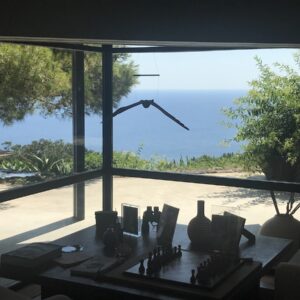
Gabriella is one of them, an architectural poet and also the individual who has most contributed to save and enhance the island of Pantelleria.
Gabriella fell in love with this island during her 1964 Christmas vacation and, from one day to another, she changed her life. She left Milan and set foot on Pantelleria, where she invested all of her savings ($400) to purchase a Dammuso, where she opened her professional studio.
From that moment on, Gabriella has been the island’s resident-architect par excellence, restoring and converting hundreds of abandoned agricultural stone shelters into sublime summer residences, including those of fashion designer Giorgio Armani, who is considered the island’s “last prince”.
What is a ‘dammuso’, you may ask. Dammuso is a word of Arabic origin that was originally intended to define a domed roof. Today, this term is used to designate the thousands of typical stone buildings that dot the countryside of Pantelleria. These buildings were originally used by local farmers as night shelters, when work in the field extended for more than a day.
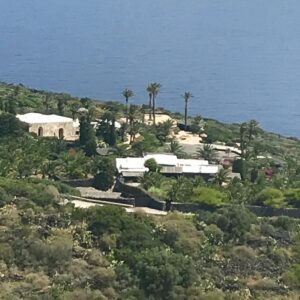
The island features over fifty volcanoes, some of which are still active, but has no fresh water. Its agriculture flourishes because of the intense night dew that feeds the thirst of its soil.
In 1965, Pantelleria was still an agricultural paradise, and its hilly landscape was extensively terraced, to take advantage of even the smallest land parcels for the production of grapes and capers.
In those years Pantelleria had very few trees, because locals believed that ornamental plants were subtracting land from the island’s agricultural production; the only exceptions were twisted olive trees, growing low and parallel to the ground to shield their fruits from the winds. Local farmers also used to build amazing stone walls to protect their most precious plants, even a single lemon or orange tree. These circular or oval walls, seven or eight feet high, were called giardini, and thousands of them are still visible throughout the island.
The most astonishing feature of the island’s landscape was its cascade of agricultural terraces supported by stone walls.
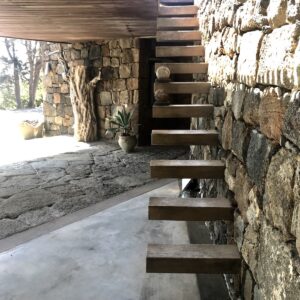
Detail of one of Gabriela Giuntoli’s projects: a staircase cantilevered from a stone wall with solid wood steps.
It was a landscape with a cultural meaning, and this meaning was how much it reflected the island’s integrated social and economic community, centered on working the land. And it was the harmony of this unique environment that attracted Gabriella to Pantelleria.
However, by the time she set foot on the island this equilibrium was beginning to crack. Many young people were leaving rather than continuing the work of their ancestors and a growing number of productive fields were being abandoned; as a result, unattended stone drywalls were slowly deteriorating and the historic landscape of Pantelleria was decaying. Moreover, by the end of the 1960s, over one thousand agricultural stone buildings were up for sale at bargain prices, attracting the interest of continental visitors hunting for low cost vacation residences.
It was the end of the agricultural economy and the beginning of tourism, a kind of tsunami that risked destroying a cultural patrimony assembled over thousands of years. It was a process of economic and cultural changes that was common to many small Mediterranean islands but, in the case of Pantelleria, there was someone determined to ‘ride the tiger’ with an architectural strategy designed to preserve and rehabilitate the abandoned dammusi. This someone was Gabriella Giuntoli, a determined and enthusiast architect ‘pasionaria’, gifted with unique sensibility and talent.
In 1970, I joined Gabriella in the launching of a project that aimed at preserving the island’s historic landscape while promoting what we called ‘qualified tourism’.
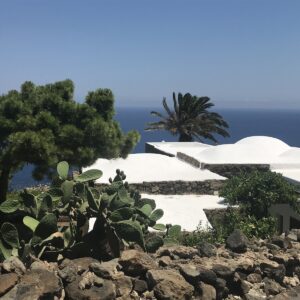
This project continued over three successive summers, and its first step was a public information campaign to enlighten the locals on the value of their environmental assets and warn them of the pitfalls of chaotic tourism developments.
We organized a think tank of young architects, sociologists, economists and media experts. This team was to set priorities and strategies for ‘saving’ the island. A few young islanders joined our team, fully aware that their future was at stake.
We began with a religious warfare approach. We pointed out that the islanders included two different groups, “Filipanti’ (from the Greek word “filos” = friend), good guys who loved the island and wanted to save it, and “Barbapanti” (from the Greek word “barbaros”), bad guys who were exploiting it. This distinction, common to sport fans, highlighted the differences and ignited a public debate. Soon the “Filipanti” were winning, and the word “barbapante” was becoming a serious insult, like “cuckold” or “fascist”.
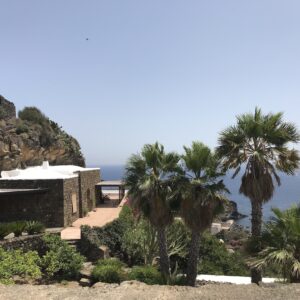
The most successful instrument of our campaign was the launching of Il Panteco (Echo of Pantelleria), the first newspaper this island had ever had, compiled almost exclusively by locals, and devoured by everyone for the following 20 years, without distinction between locals and tourists.
Another project was a photomural exhibition to illustrate the diagnosis of the process and the possible therapies.
The Bible of the ‘Filopanti’ was a small essay written by Gabriella by the title of “Abitare un Dammuso” (“Inhabiting a Dammuso”), a detailed architectural handbook on how to restore and convert these prehistoric constructions into residences, without compromising their cultural identity.

But actions speak louder than words, and Gabriella’s first renovation projects became the reference models to follow. The brilliance of these projects was in her minimal modifications to the existing stone envelope, the framing of the internal alcoves by simply raising their floors, the polished cement finish (a first for the time), the spatial enhancement of the interior domed spaces, the almost invisible window frames, and the graceful openings through the exterior stone walls to maximize sunlight penetration.
The buildings’ restoration works were complemented by the creation of external patio gardens screened by stone walls and covered with traditional straw mats. These patios extended the livable space of these buildings and allowed their residents to live outdoor in complete privacy and protected from the sun and the winds.
While reminding me of the works of Frank Lloyd Wright in Arizona, Luis Barragan in Mexico and Roberto Burle Marx in Brazil, Gabriella’s projects were authentically local in both form and spirit.
This architectural language caught the island by storm, and while the number of Gabriella’s clients kept rising, her functional and aesthetic solutions were freely copied by most of the island’s builders.
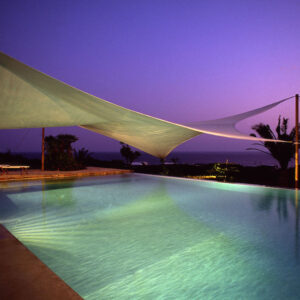
But, far from invoking a copyright, Gabriella was blessing her imitators because, by doing so, they were limiting the visual damages.
Thanks to Gabriella some sacrilegious interventions, such as whitewashing the stones, or introducing folkloric moldings or horns to the roofs of the dammusi became blasphemous. And it is thanks to her that many electrical poles in panoramic zones were removed, with the electrical cables placed underground. Moreover, thanks to Gabriella, many abandoned fields surrounding the converted stone shelters were turned into splendid gardens. As a result, today Pantelleria has become a green island.











